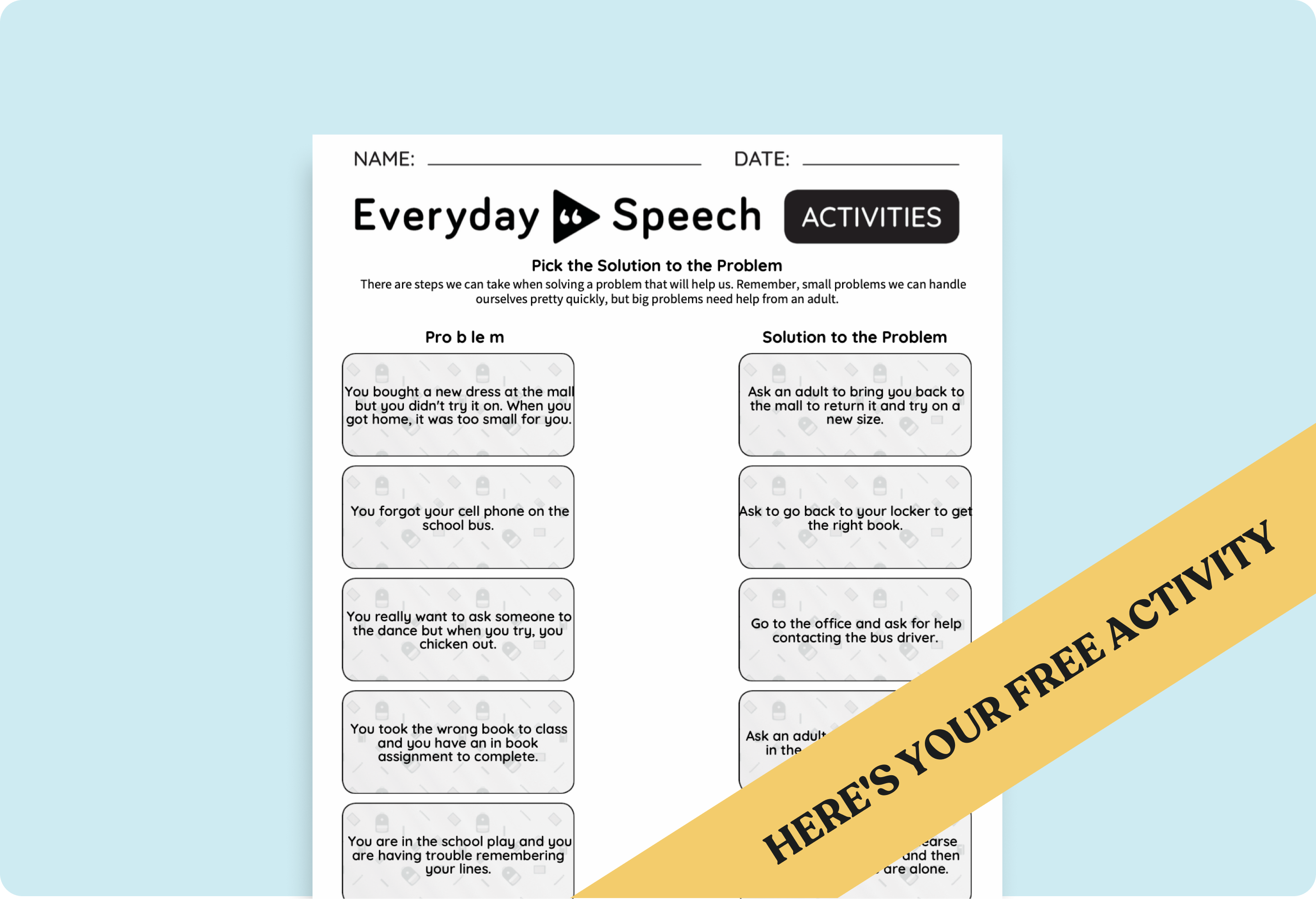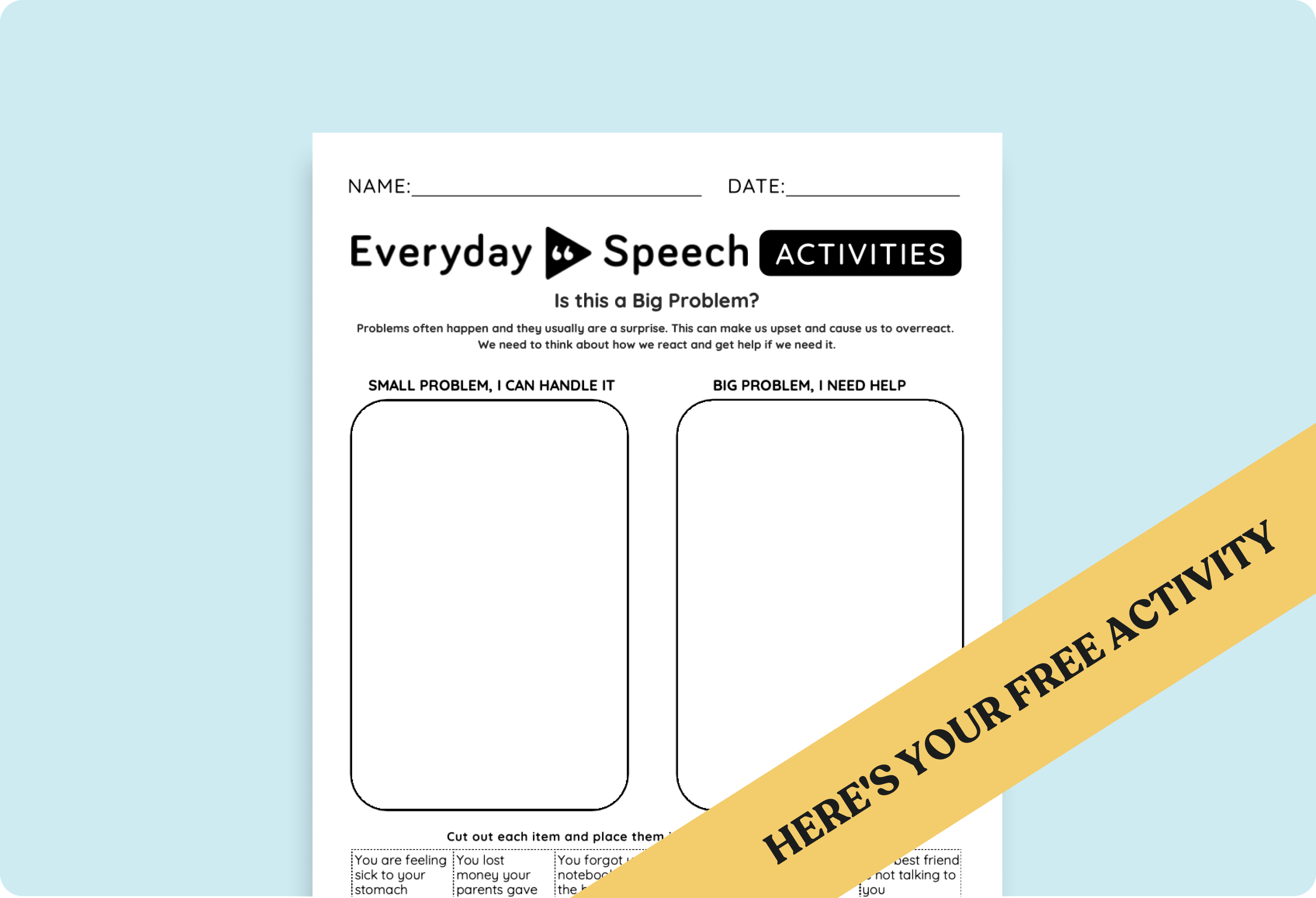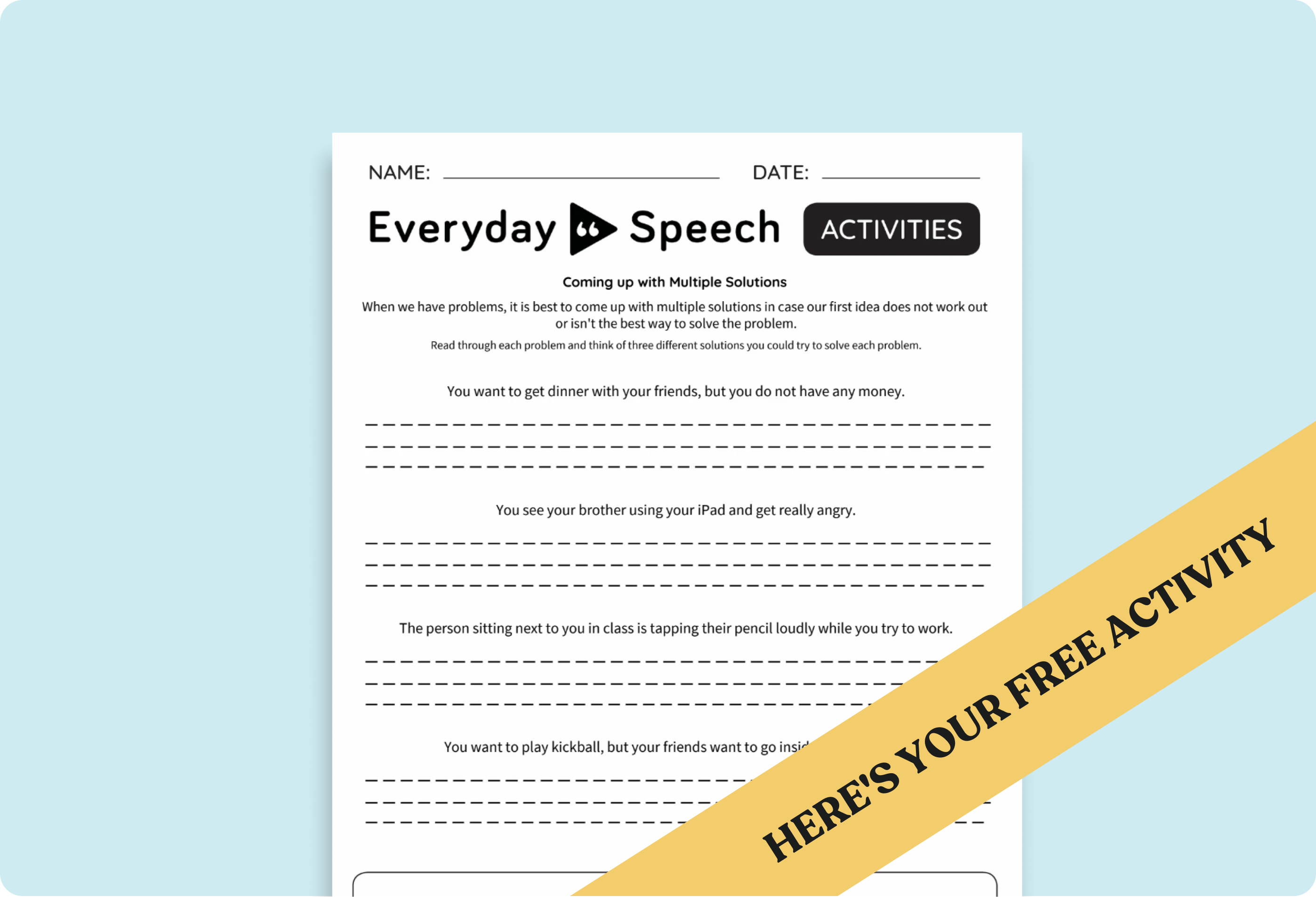The Best No-Prep Problem-Solving Activities for PK-12 Students
Get free social skills materials
No-prep lessons on self-regulation, emotional recognition, conversation skills, and more.
Sign up hereProblem-solving is an essential skill that helps students navigate challenges in academics, relationships, and daily life. Whether working through a math problem, resolving a disagreement, or making a decision about time management, problem-solving encourages critical thinking, adaptability, and independence.
In an educational setting, problem-solving goes beyond simply finding the right answer. It involves analyzing a situation, considering different perspectives, and evaluating potential solutions. By developing these skills, students learn to think strategically, make informed decisions, and approach challenges with confidence.
The following sections explore why problem-solving is a foundational skill, how educators can teach it effectively, and different types of problem-solving activities that engage students at every grade level.
Get Free Problem-Solving Activities for PK-12
No-prep worksheets, games, and lesson plans for your classroom or therapy sessions.
What is Problem-Solving?
Problem-solving is the process of identifying a challenge, exploring possible solutions, and taking action to resolve it. It is an essential skill for students at all grade levels, helping them think critically, make decisions, and handle academic and social situations with confidence.
In an educational setting, problem-solving involves more than just finding the right answer. It requires students to analyze a situation, weigh different options, and consider the consequences of their choices. Whether they are working through a math problem, resolving a disagreement with a peer, or deciding how to organize their schoolwork, students who develop strong problem-solving skills become more independent and adaptable learners.
Why Teach Problem-Solving?
Teaching problem-solving equips students with essential life skills, helping them manage frustration, tackle challenges with confidence, and collaborate effectively. There are several key benefits to teaching problem-solving in the classroom:
- Encourages critical thinking: Students analyze situations, evaluate perspectives, and explore multiple solutions before deciding.
- Builds social skills: Problem-solving fosters teamwork, communication, and conflict resolution.
- Improves academic performance: Strong problem-solving abilities support success in subjects like math, science, and writing.
- Boosts confidence and independence: A structured approach helps students feel more in control and develop resilience.
These skills are essential in and beyond the classroom. By integrating problem-solving activities into everyday learning, educators help students develop a lifelong ability to navigate challenges effectively.
How to Teach Problem-Solving
Problem-solving is most effective when it is taught explicitly through structured strategies and real-world application. Students learn best when they have a clear framework to follow and opportunities to practice problem-solving in different contexts.
One effective approach is to introduce a step-by-step problem-solving model that students can use across different situations. A simple four-step framework includes:
- Identify the problem: Define what the challenge is and why it needs to be solved.
- Think of possible solutions: Consider multiple ways to address the problem rather than immediately acting on the first idea.
- Choose the best solution: Evaluate the options and select the most effective and realistic course of action.
- Reflect on the outcome: After implementing the solution, consider whether it worked and if anything should be done differently next time.
To reinforce these skills, educators can incorporate problem-solving into classroom activities in several ways.
- Use real-world scenarios: Present students with challenges they may encounter in their daily lives, such as resolving a disagreement with a classmate or deciding how to manage their time effectively.
- Engage students in discussions: Facilitate class conversations where students analyze problems together, debate different solutions, and discuss their reasoning.
- Incorporate hands-on activities: Use games, role-playing, and interactive exercises that encourage students to apply problem-solving strategies in a fun and engaging way.
- Encourage reflection: Have students think about how they approached a problem and what they learned to reinforce problem-solving as an ongoing skill.
By consistently integrating problem-solving instruction into daily lessons, educators help students build confidence and develop a structured approach to tackling challenges. Check out the no-prep activities next to get started.
No-Prep Problem-Solving Activities for PK-12
Problem-solving is a crucial life skill, but it’s not something students just “figure out” on their own—it needs to be explicitly taught and practiced. Whether it’s a preschooler learning to ask for help, an elementary student deciding between multiple solutions, or a high schooler navigating group conflicts, structured problem-solving activities can help students develop confidence, independence, and critical thinking skills.
This collection of free, no-prep problem-solving resources includes posters, worksheets, and interactive activities designed for students at every grade level. From recognizing the size of a problem to brainstorming creative solutions, these engaging lessons provide practical tools for handling challenges in academic and social settings.
Explore the resources below to find the perfect problem-solving lesson plan for your classroom!
Get Free Problem-Solving Activities for PK-12
No-prep worksheets, games, and lesson plans for your classroom or therapy sessions.
Classroom Poster: Problem-Solving Process
Give students a clear, structured problem-solving process with this free classroom poster and lesson plan. By following a simple four-step method, students will learn how to assess challenges, think critically, and make confident decisions in academic and social situations.
How to Use It:
- Display the Problem-Solving Process Poster in a visible classroom location as a reference tool.
- Walk students through real-world examples using the four-step problem-solving method.
- Engage students with interactive activities, including role-playing and group discussions.
- Have students apply their learning through independent problem-solving exercises.
Why It Matters:
- Helps students develop independent decision-making skills.
- Provides a simple, repeatable framework for solving everyday problems.
- Reinforces critical thinking and logical reasoning through hands-on activities.
Activity for Preschool: Who Can Help?
Help preschoolers learn to identify trusted helpers with this engaging problem-solving activity. This free printable worksheet guides young learners in recognizing who to ask for help in different situations, building their confidence and independence.
How to Use It:
- Start with a class discussion about trusted helpers at home, school, and in the community.
- Introduce real-world problem scenarios and guide students in choosing the correct helper.
- Use the “My Helpers” worksheet to let students practice matching problems with the right person to ask for help.
- Engage students with role-playing activities to reinforce problem-solving in everyday situations.
Why It Matters:
- Teaches children to feel safe and supported by recognizing who can help them.
- Builds early problem-solving skills by encouraging them to think before reacting.
- Reinforces confidence in asking for help, preparing them for school and social interactions.
Interactive Activity for Preschool: How to Ask for Help
Teach preschoolers how to recognize when they need help and ask for it confidently with this interactive problem-solving activity. This free sequencing activity helps young learners practice the step-by-step process of seeking help, reinforcing communication, independence, and problem-solving skills.
How to Use It:
- Start with a class discussion on when and how to ask for help.
- Walk through real-life problem scenarios, helping students understand the steps.
- Have students complete the interactive sequencing activity, where they arrange steps in the correct order.
- Use role-playing exercises to reinforce asking for help in different situations.
Why It Matters:
- Encourages independent problem-solving while teaching students when to seek support.
- Strengthens social-emotional skills, helping children communicate their needs effectively.
- Builds confidence in self-advocacy, so children feel comfortable asking for help when needed.
Activity for Preschool & Kindergarten: My Problem-Solving Toolbox
Help young learners develop confidence in handling everyday challenges with this interactive Problem-Solving Toolbox activity. This free printable guides preschoolers and kindergarteners through choosing and using problem-solving strategies in real-life situations.
How to Use It:
- Introduce problem-solving steps in a fun, engaging discussion.
- Help students brainstorm common classroom challenges and different ways to solve them.
- Have students build their own Problem-Solving Toolbox by selecting three strategies they can use in tricky situations.
- Practice applying problem-solving strategies with real-world preschool scenarios.
Why It Matters:
- Encourages independent problem-solving by giving young learners a structured way to handle challenges.
- Teaches emotional regulation by showing students how to pause, assess, and choose a response instead of reacting impulsively.
- Builds social skills by helping children learn cooperation, sharing, and communication strategies.
Printable Worksheet for Elementary: Pick the Solution
Help young learners develop problem-solving confidence by recognizing when they can handle challenges independently and when they should seek help. This worksheet guides students through real-world scenarios, helping them evaluate solutions and make thoughtful decisions.
How to Use It:
- Begin with a class discussion on common school-day challenges and how students typically handle them.
- Introduce the five-step problem-solving framework and apply it to real-world scenarios.
- Have students complete the worksheet independently or in small groups, selecting the best solutions for different situations.
- Wrap up with reflection questions to reinforce critical thinking and decision-making strategies.
Why It Matters:
- Helps students differentiate between big and small problems and determine appropriate solutions.
- Encourages independent thinking and responsible decision-making.
- Provides structured, hands-on practice to build problem-solving confidence.
Printable Worksheet for Middle School: ‘Size of the Problem’
Help middle school students develop problem-solving confidence by teaching them how to assess the size of a problem before reacting. This structured lesson plan and worksheet help students recognize when a challenge is small enough to handle independently or when it requires additional support.
How to Use It:
- Introduce the concept of small vs. big problems through class discussions.
- Guide students through a categorization activity to help them recognize different problem types.
- Use the ‘Is This a Big Problem?’ worksheet to reinforce critical thinking and problem-solving strategies.
- Encourage students to reflect on how understanding problem size can help them manage emotions and find effective solutions.
Why It Matters:
- Teaches students to assess challenges rationally, reducing overreactions to minor issues.
- Helps students recognize when they can problem-solve independently versus when they need support.
- Strengthens emotional regulation and decision-making for both academic and social situations.
Printable Worksheet for Middle School: Identifying the Problem
Help middle school students build stronger problem-solving skills by teaching them how to define and assess challenges before reacting. This structured lesson plan and worksheet guide students through the process of recognizing real problems, assessing their size, and determining when to seek help.
How to Use It:
- Lead a class discussion on common middle school challenges and how students typically react.
- Teach the three-step problem-solving process: Define the problem, assess its size, and decide on a response.
- Use the Problem-Solving Worksheet to help students analyze real-world scenarios.
- Encourage group discussions and reflection exercises to reinforce problem-identification skills.
Why It Matters:
- Helps students think before reacting, reducing impulsive decision-making.
- Encourages logical problem analysis, making it easier to find appropriate solutions.
- Builds emotional regulation and independence, helping students manage everyday challenges with confidence.
Interactive Activity for Middle School: Learning to Compromise
Help middle school students navigate conflicts and collaborate effectively with this interactive compromise activity. This lesson plan and online activity teach students how to find fair solutions, respect different perspectives, and communicate their needs when faced with disagreements.
How to Use It:
- Start with a class discussion on what compromise means and why it’s important.
- Introduce real-life conflict scenarios and guide students in brainstorming fair solutions.
- Have students complete the Compromising with Others interactive activity, matching the best solutions to each situation.
- Wrap up with a reflection discussion on how compromise applies to daily life.
Why It Matters:
- Helps students develop stronger communication and teamwork skills.
- Encourages flexibility and problem-solving, reducing frustration in group settings.
- Teaches students how to balance their needs with others’ perspectives, improving friendships and collaboration.
Lesson Plan for Middle & High School: The Problem Scale
Help high school students develop independent problem-solving skills with The Problem Scale—a simple framework that teaches them how to assess challenges and respond appropriately. This free lesson plan and poster guide students through evaluating problems logically before reacting.
How to Use It:
- Introduce students to The Problem Scale and discuss how to categorize challenges as very small, small, medium, big, or very big.
- Use real-world high school scenarios to help students practice assessing problem size.
- Guide students through structured problem-solving discussions using The Problem Scale as a reference.
- Reinforce learning with independent reflection and classroom discussions.
Why It Matters:
- Helps students differentiate between minor and major challenges, reducing impulsive reactions.
- Encourages independent decision-making by teaching students when they can solve problems on their own and when they need support.
- Improves emotional regulation and critical thinking, building skills they’ll use in high school and beyond.
Printable Worksheet for High School: Brainstorming Solutions
Help high school students develop flexible thinking and independent decision-making with this free problem-solving activity. This lesson plan and worksheet teach students how to generate multiple solutions to challenges, avoid impulsive reactions, and make thoughtful choices.
How to Use It:
- Lead a classroom discussion on common high school challenges and typical responses.
- Guide students through the problem-solving process, emphasizing the importance of brainstorming multiple solutions.
- Have students complete the Problem-Solving Worksheet, applying critical and creative thinking to real-world scenarios.
- Facilitate group discussions to evaluate different solutions and decision-making strategies.
Why It Matters:
- Encourages critical thinking by helping students consider multiple perspectives and creative solutions.
- Reduces impulsive decision-making, reinforcing the habit of pausing to evaluate options before reacting.
- Builds real-world problem-solving skills that prepare students for academic, social, and future career challenges.
Printable Worksheet for High School: Problem-Solving in Groups
Help high school students collaborate, communicate, and resolve challenges effectively with this structured group problem-solving lesson plan. This free worksheet and activity guide students through defining problems, brainstorming solutions, and making decisions as a team.
How to Use It:
- Lead a class discussion on the benefits and challenges of group problem-solving.
- Introduce the five-step problem-solving process to guide structured teamwork.
- Have students apply the process to real-world scenarios using the Group Problem-Solving Worksheet.
- Encourage reflection on teamwork, compromise, and effective communication.
Why It Matters:
- Helps students develop collaboration skills essential for group projects and real-world decision-making.
- Encourages active listening and compromise, reducing conflict and improving teamwork.
- Teaches students a structured approach to solving challenges as a group, preventing indecision and inefficiency.
More Ways to Teach Problem-Solving
While these no-prep activities provide a simple way to reinforce problem-solving skills, incorporating a variety of approaches ensures that all students have opportunities to develop these abilities in meaningful ways.
Types of Problem-Solving Activities
Problem-solving can take many forms, from structured exercises to open-ended challenges. The most effective activities engage students in critical thinking, encourage creativity, and provide hands-on learning experiences.
Different types of problem-solving activities include:
- Critical thinking challenges – Logic puzzles, brain teasers, and decision-making exercises help students analyze information and apply reasoning.
- Discussion-based problem-solving – Classroom debates, peer discussions, and case studies encourage students to consider different perspectives.
- Role-playing and social problem-solving – Practicing real-life scenarios helps students develop teamwork, negotiation, and conflict resolution skills.
- Games and interactive activities – Board games, online simulations, and collaborative challenges make problem-solving engaging and low-pressure.
- Worksheets and structured exercises – Graphic organizers, problem-solving charts, and structured reflection prompts guide students through the decision-making process.
Each type of activity can be adapted for different age groups and learning styles. Incorporating a variety of exercises ensures that students develop problem-solving skills in ways that resonate with them.
How to Choose the Right Problem-Solving Activity for Your Students
Not all problem-solving activities suit every classroom or age group. When selecting an activity, educators should consider students’ developmental levels, lesson objectives, and engagement preferences.
- Preschool and kindergarten – Simple, hands-on activities like storytelling, role-playing, and movement-based exercises help young learners build problem-solving foundations.
- Elementary – Structured games, group discussions, and guided worksheets encourage logical thinking and decision-making.
- Middle school – More complex challenges, such as real-world problem analysis, team-based projects, and debates, support independent thinking and collaboration.
- High school – Case studies, research-based decision-making, and structured discussions help students refine reasoning and communication skills.
Offering a mix of problem-solving approaches ensures that all students can engage in ways that suit their learning styles. By selecting activities that match their developmental level and interests, educators create meaningful learning experiences that foster confidence, independence, and resilience.
Get Free Problem-Solving Activities for PK-12
No-prep worksheets, games, and lesson plans for your classroom or therapy sessions.
Helping Students Build Lifelong Problem-Solving Skills
Problem-solving is more than just an academic skill—it’s a fundamental ability that prepares students for success in school, relationships, and life beyond the classroom. By teaching students how to analyze challenges, consider different solutions, and make informed decisions, educators help them develop confidence, independence, and resilience.
Whether through structured worksheets, hands-on activities, or interactive discussions, problem-solving can be integrated into daily learning at every grade level. Providing students with a variety of engaging activities ensures they have the tools they need to navigate both simple and complex challenges.
Explore the free, no-prep problem-solving activities included in this guide to find resources that best fit your classroom. By fostering strong problem-solving skills today, educators are equipping students with the strategies they’ll use for a lifetime.



